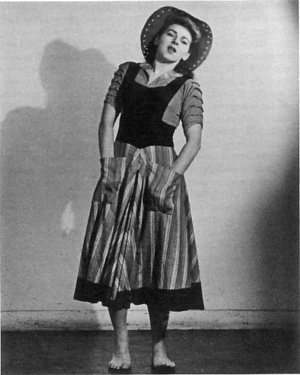Sophie Maslow
Sophie Maslow was my father's first cousin; she was born and lived all her life in New York City. I had never heard of Sophie Maslow until I met her when I was almost fourteen. The meeting was only by chance. In 1964, my parents had invited my seven year old cousin, Tobias Baskin, to accompany our family on a visit to the New York World's Fair. We lived in Hamilton, Ontario, where my father was the Reform Rabbi between 1949 and 1988. Tobias was the son of the artist and sculptor, Leonard Baskin, my father's brother, who lived in Northampton, MA. After several enjoyable days at the fair, we dropped Toby off at Sophie's apartment on the Upper West Side, where his father was to pick him up later. When I walked into Sophie's apartment, crowded with art and books, I felt I was entering a new world of life possibilities. Sophie lived with her husband Max Blatt and her daughter Abigail, then around seventeen. Max, an artist and teacher, had a full head of white hair; Abby was friendly and vivacious. I remember a lively lunch, full of animated discussion among the adults, a bit of a tour of the neighborhood (the mid-eighties around Columbus Ave.) with Abby, and then my family was in the car again, headed out of the city.
Of course, I wanted to know why I had never before met - or even heard about - these fascinating relatives. Over the years I have pieced together the following: Sophie was the daughter of Elizabeth Baskin Maslow and Isaac Maslow. Elizabeth, known as Lisa (pronounced Leeza), was the older sister of Rabbi Samuel Baskin, my paternal grandfather; Samuel and Lisa were two of the four children of a miller and his wife and had grown up in what is now Belarus. I know very little about the family's circumstances but my great-grandfather must have been prosperous. Elizabeth attended gymnasium; another brother became a physician and moved to Moscow. My grandfather, Samuel, left the family home early on to study in Vilna. He was a student of the Chafetz Chaim, received rabbinic ordination at eighteen, and came to the United States, prior to the outbreak of World War I. Elizabeth and a fourth brother were already in America.
According to my father (who was born in 1920), my grandfather and his sister Elizabeth remained close, despite their very different approaches to life. My grandfather was an Orthodox rabbi with a congregation on Bedford Avenue in Brooklyn, while Elizabeth and her husband were secular Jews who were deeply committed to leftwing politics and causes. My father remembers Aunt Lisa as a handsome and impressive woman who wore her hair in a braided crown. She and her family, which included Sophie and a brother, Bernard, attended Passover sedarim with the Baskin family. My father recalls that Sophie's father was an extremely nice and jovial man who sometimes took the Baskin children for rides in his car - a rare treat for city-reared children. Aunt Lisa would often bring gifts of books for my dad and his siblings - volumes of fairy tales and also books about collective farms in the Soviet Union. My grandfather officiated at Sophie Maslow's wedding with Max Blatt, probably some time in the 1930s.
Sophie was involved with dance from a very young age; she took her first classes in interpretive dance, music, and elocution at a socialist school on 16th St. It was at the Neighborhood Playhouse, a popular theatre on the Lower East Side that grew out of the Henry Street Settlement, that Sophie first took classes from Martha Graham whose company she joined in 1931. My father remembers going to concerts at Brooklyn College and elsewhere where Sophie performed. He recalls that my grandfather was very skeptical of Sophie's dance endeavors, just as he was later doubtful about my uncle's determination to be an artist. For my father and Leonard, Sophie and Max represented the bohemian world; my father remembers their exciting visits to the Blatt's apartment in Greenwich Village. My father and his brother took very different directions. My father chose a conventional path: he was ordained at the Jewish Institute of Religion and had left New York City by the mid-1940s; he did not maintain ties with his cousins. Leonard, on the other hand, remained close to Sophie and Max throughout his life and also shared their socialist politics which inspired Sophie's dances and Leonard's art.
I reconnected with Sophie, Max, and Abby when I spent several months in New York City in the late 1960s. I was impressed with their cosmopolitan life style and their famous friends, including their close ties with Woody Guthrie and his family. In December, 1967, I enjoyed the Hanukkah Festival that Sophie choreographed at Madison Square Gardens. I have never been a dancer or knowledgeable about dance. Only later, did I come to appreciate the depth of Sophie's talent and dedication and how difficult it must have been for her to forge her career as both a dancer and a choreographer, while also maintaining a marriage and bringing up a daughter. It is inspiring to see the way her legacy and her choreography are being rediscovered and recognized by a new generation of scholars and dancers.



